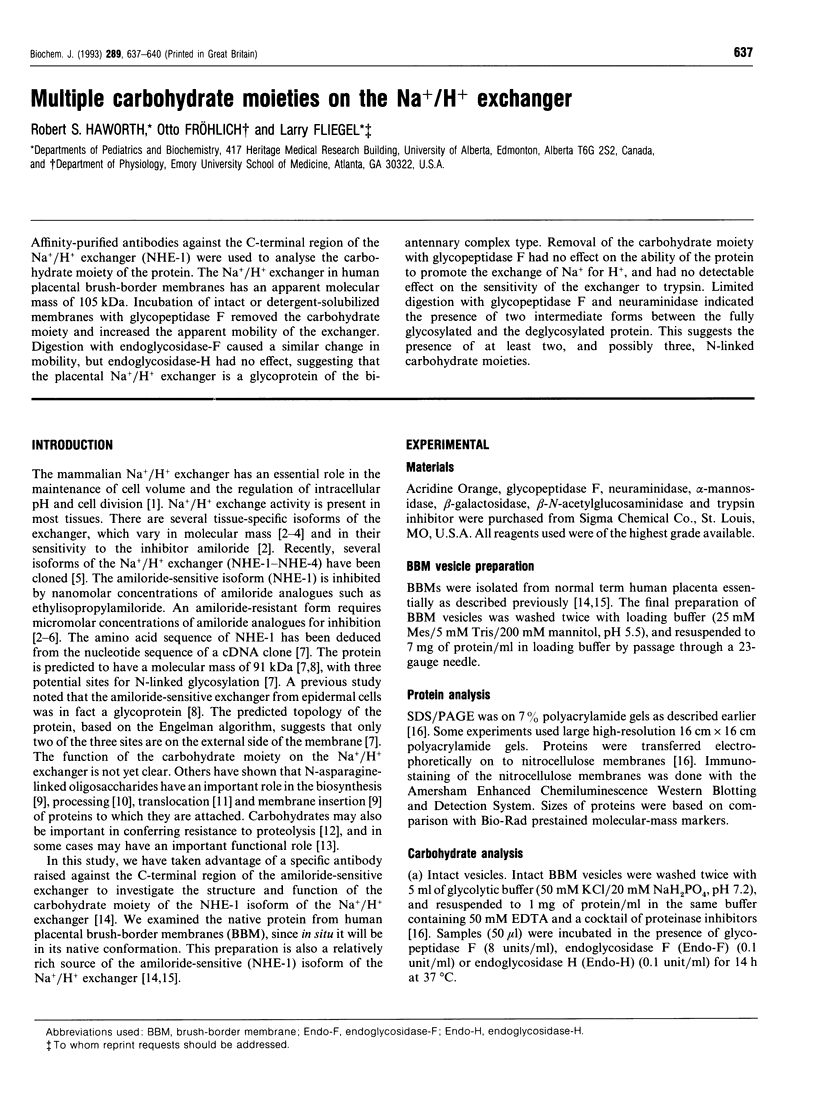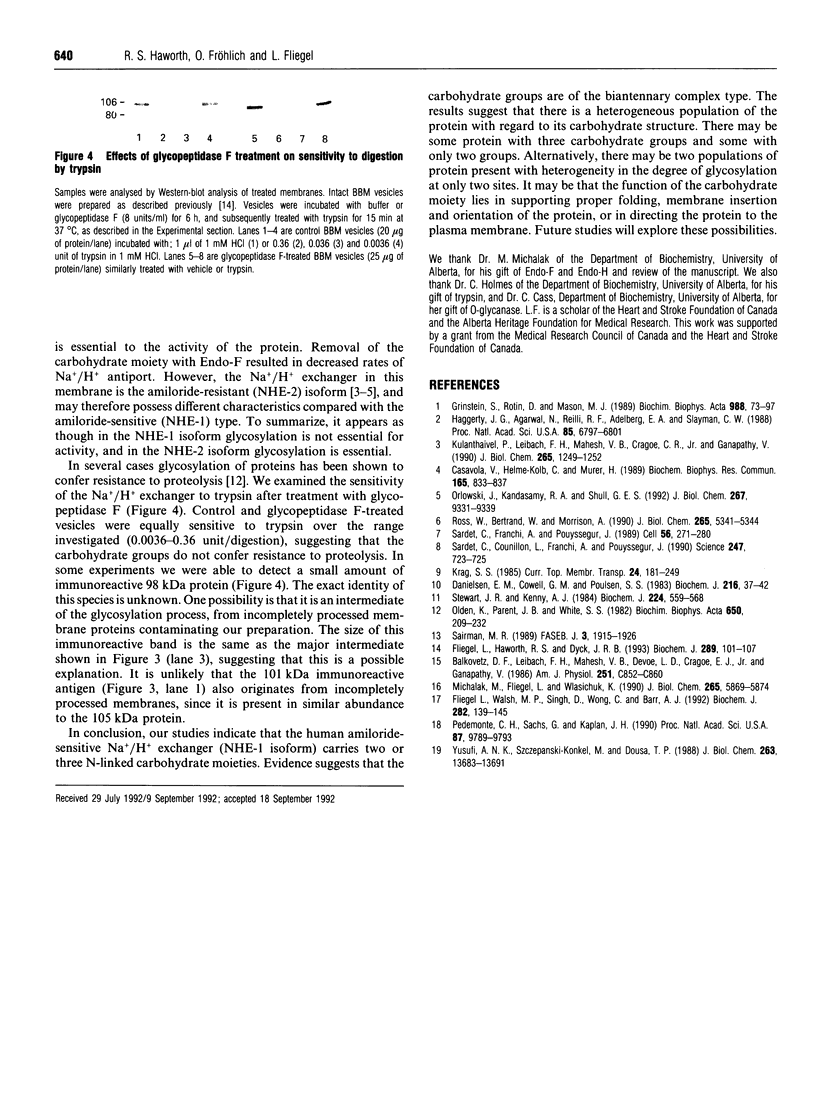Abstract
Affinity-purified antibodies against the C-terminal region of the Na+/H+ exchanger (NHE-1) were used to analyse the carbohydrate moiety of the protein. The Na+/H+ exchanger in human placental brush-border membranes has an apparent molecular mass of 105 kDa. Incubation of intact or detergent-solubilized membranes with glycopeptidase F removed the carbohydrate moiety and increased the apparent mobility of the exchanger. Digestion with endoglycosidase-F caused a similar change in mobility, but endoglycosidase-H had no effect, suggesting that the placental Na+/H+ exchanger is a glycoprotein of the biantennary complex type. Removal of the carbohydrate moiety with glycopeptidase F had no effect on the ability of the protein to promote the exchange of Na+ for H+, and had no detectable effect on the sensitivity of the exchanger to trypsin. Limited digestion with glycopeptidase F and neuraminidase indicated the presence of two intermediate forms between the fully glycosylated and the deglycosylated protein. This suggests the presence of at least two, and possibly three, N-linked carbohydrate moieties.
Full text
PDF



Images in this article
Selected References
These references are in PubMed. This may not be the complete list of references from this article.
- Balkovetz D. F., Leibach F. H., Mahesh V. B., Devoe L. D., Cragoe E. J., Jr, Ganapathy V. Na+-H+ exchanger of human placental brush-border membrane: identification and characterization. Am J Physiol. 1986 Dec;251(6 Pt 1):C852–C860. doi: 10.1152/ajpcell.1986.251.6.C852. [DOI] [PubMed] [Google Scholar]
- Casavola V., Helmle-Kolb C., Murer H. Separate regulatory control of apical and basolateral Na+/H+ exchange in renal epithelial cells. Biochem Biophys Res Commun. 1989 Dec 15;165(2):833–837. doi: 10.1016/s0006-291x(89)80041-5. [DOI] [PubMed] [Google Scholar]
- Danielsen E. M., Cowell G. M., Poulsen S. S. Biosynthesis of intestinal microvillar proteins. Role of the Golgi complex and microtubules. Biochem J. 1983 Oct 15;216(1):37–42. doi: 10.1042/bj2160037. [DOI] [PMC free article] [PubMed] [Google Scholar]
- Fliegel L., Haworth R. S., Dyck J. R. Characterization of the placental brush border membrane Na+/H+ exchanger: identification of thiol-dependent transitions in apparent molecular size. Biochem J. 1993 Jan 1;289(Pt 1):101–107. doi: 10.1042/bj2890101. [DOI] [PMC free article] [PubMed] [Google Scholar]
- Fliegel L., Walsh M. P., Singh D., Wong C., Barr A. Phosphorylation of the C-terminal domain of the Na+/H+ exchanger by Ca2+/calmodulin-dependent protein kinase II. Biochem J. 1992 Feb 15;282(Pt 1):139–145. doi: 10.1042/bj2820139. [DOI] [PMC free article] [PubMed] [Google Scholar]
- Grinstein S., Rotin D., Mason M. J. Na+/H+ exchange and growth factor-induced cytosolic pH changes. Role in cellular proliferation. Biochim Biophys Acta. 1989 Jan 18;988(1):73–97. doi: 10.1016/0304-4157(89)90004-x. [DOI] [PubMed] [Google Scholar]
- Haggerty J. G., Agarwal N., Reilly R. F., Adelberg E. A., Slayman C. W. Pharmacologically different Na/H antiporters on the apical and basolateral surfaces of cultured porcine kidney cells (LLC-PK1). Proc Natl Acad Sci U S A. 1988 Sep;85(18):6797–6801. doi: 10.1073/pnas.85.18.6797. [DOI] [PMC free article] [PubMed] [Google Scholar]
- Kulanthaivel P., Leibach F. H., Mahesh V. B., Cragoe E. J., Jr, Ganapathy V. The Na(+)-H+ exchanger of the placental brush-border membrane is pharmacologically distinct from that of the renal brush-border membrane. J Biol Chem. 1990 Jan 25;265(3):1249–1252. [PubMed] [Google Scholar]
- Michalak M., Fliegel L., Wlasichuk K. Isolation and characterization of calcium binding glycoproteins of cardiac sarcolemmal vesicles. J Biol Chem. 1990 Apr 5;265(10):5869–5874. [PubMed] [Google Scholar]
- Olden K., Parent J. B., White S. L. Carbohydrate moieties of glycoproteins. A re-evaluation of their function. Biochim Biophys Acta. 1982 May 12;650(4):209–232. doi: 10.1016/0304-4157(82)90017-x. [DOI] [PubMed] [Google Scholar]
- Orlowski J., Kandasamy R. A., Shull G. E. Molecular cloning of putative members of the Na/H exchanger gene family. cDNA cloning, deduced amino acid sequence, and mRNA tissue expression of the rat Na/H exchanger NHE-1 and two structurally related proteins. J Biol Chem. 1992 May 5;267(13):9331–9339. [PubMed] [Google Scholar]
- Pedemonte C. H., Sachs G., Kaplan J. H. An intrinsic membrane glycoprotein with cytosolically oriented n-linked sugars. Proc Natl Acad Sci U S A. 1990 Dec;87(24):9789–9793. doi: 10.1073/pnas.87.24.9789. [DOI] [PMC free article] [PubMed] [Google Scholar]
- Ross W., Bertrand W., Morrison A. A photoactivatable probe for the Na+/H+ exchanger cross-links a 66-kDa renal brush border membrane protein. J Biol Chem. 1990 Apr 5;265(10):5341–5344. [PubMed] [Google Scholar]
- Sairam M. R. Role of carbohydrates in glycoprotein hormone signal transduction. FASEB J. 1989 Jun;3(8):1915–1926. doi: 10.1096/fasebj.3.8.2542111. [DOI] [PubMed] [Google Scholar]
- Sardet C., Counillon L., Franchi A., Pouysségur J. Growth factors induce phosphorylation of the Na+/H+ antiporter, glycoprotein of 110 kD. Science. 1990 Feb 9;247(4943):723–726. doi: 10.1126/science.2154036. [DOI] [PubMed] [Google Scholar]
- Sardet C., Franchi A., Pouysségur J. Molecular cloning, primary structure, and expression of the human growth factor-activatable Na+/H+ antiporter. Cell. 1989 Jan 27;56(2):271–280. doi: 10.1016/0092-8674(89)90901-x. [DOI] [PubMed] [Google Scholar]
- Stewart J. R., Kenny A. J. Proteins of the kidney microvillar membrane. Effects of monensin, vinblastine, swainsonine and glucosamine on the processing and assembly of endopeptidase-24.11 and dipeptidyl peptidase IV in pig kidney slices. Biochem J. 1984 Dec 1;224(2):559–568. doi: 10.1042/bj2240559. [DOI] [PMC free article] [PubMed] [Google Scholar]






